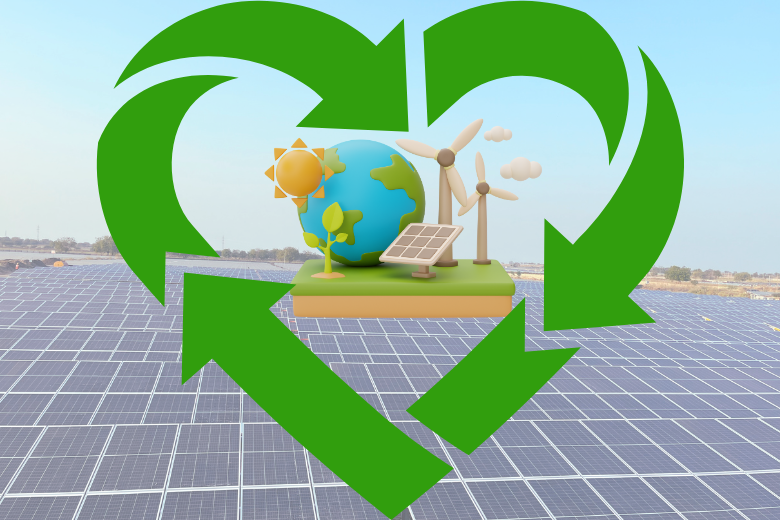It is Time for India’s Solar Industry to Start Making Significant Strides Towards Solar Waste Management
4PEL Staff
April 2024

In recent years, India has made remarkable strides in harnessing Renewable Energy, with its Solar capacity witnessing exponential growth and currently at over 82 GW of installed capacity. However, with progress comes responsibility – and one crucial aspect that demands attention is the management of Solar Waste. As the industry continues to expand, addressing the issue of waste and recycling of panels, other equipment becomes imperative for environmental sustainability and economic viability.
What is Solar Waste and Why Does it Matter?
Solar waste encompasses discarded solar modules and scrap generated during manufacturing. These modules contain valuable materials like silicon, glass, and even some hazardous substances like lead and cadmium. Improper disposal of these panels can lead to environmental hazards like soil and water contamination.

Here's why India, with its ambitious solar goals, needs a robust solar waste management system:
- Exponential Growth: India's commitment to solar energy is evident from its significant increase in solar capacity, which stood at 66.7 GW as of March 2023 and is projected to reach 292 GW by 2030. With this growth comes the responsibility of managing solar waste efficiently. By 2030, India is expected to generate approximately 340 kt of solar waste, with five states—Rajasthan, Gujarat, Karnataka, Tamil Nadu, and Andhra Pradesh—accounting for 67% of this waste due to their higher solar capacity.
- Environmental Threat: Landfilling these panels is a recipe for disaster. Toxic materials can leach into the soil and water, while improper burning releases harmful gases into the air.
- Resource Recovery: Solar panels contain valuable resources like silicon and other critical minerals. Proper recycling can not only lessen our dependence on virgin materials but also create a secondary resource stream.

India’s Efforts Towards Efficient Solar Waste Management
- - E-waste Management Rules (2022):
India began tackling solar waste management in 2022 with the update of its E-waste Management Rules. This update brought solar panels, modules, and cells under its wing. The new rules focus on responsible handling by producers: they must store the waste they generate until 2034-2035 according to Central Pollution Control Board (CPCB) guidelines and report annually on an e-waste management portal during this period. Recyclers also have a role to play, following CPCB guidelines to recover materials from the waste. - - Green Credit Programme:
Green Credit Programme, launched under the Environmental Protection Act of 1986 and announced in the UB 2022-2023, encourages green growth and sustainable practices by providing incentives for environmentally friendly actions. - - Draft Solar Waste Management Rules:
In 2019, the Central Pollution Control Board (CPCB) released draft rules for the management of solar waste. These rules delineate the responsibilities of manufacturers, recyclers, and regulatory bodies in the recycling and disposal process. By outlining clear guidelines and responsibilities, these rules aim to streamline the management of solar waste, ensuring effective recycling and disposal practices are in place. - - Extended Producer Responsibility (EPR):
The Ministry of Environment, Forest and Climate Change (MoEFCC) has introduced Extended Producer Responsibility (EPR) regulations for electronic waste, including solar panels. Under these regulations, manufacturers are held accountable for managing the end-of-life disposal of their products. By placing the responsibility on manufacturers, EPR regulations incentivize the adoption of sustainable production practices and encourage manufacturers to design products with recyclability and end-of-life disposal in mind.
Key Challenges in Solar Waste Management
Despite these initiatives, India grapples with several challenges in photovoltaic waste management. Informal handling, inadequate disposal practices, and the lack of suitable incentives for recycling contribute to the growing accumulation of solar waste. Pollution from improper disposal exacerbates environmental risks, necessitating urgent action to address these issues comprehensively.
A Sustainable Approach: Fourth Partner Energy's Contribution
Fourth Partner Energy (FPEL) has implemented proactive measures to ensure responsible disposal of damaged modules. With a commitment to environmental sustainability, FPEL has established a structured process for managing solar waste. All damaged modules are systematically stored in designated areas, awaiting proper disposal. FPEL collaborates with State Pollution Control Boards (SPCB) and Pollution Control Boards (PCB) approved vendors to obtain quotations for the disposal of solar waste. Upon approval, FPEL issues Form-6 E-waste manifests for disposal, ensuring compliance with regulatory requirements. This meticulous approach demonstrates FPEL's dedication to mitigating the environmental impact of solar waste while upholding regulatory standards.
In the quest for a sustainable energy future, the management of solar waste emerges as a critical frontier. Through concerted efforts from government bodies, industry players, and responsible corporations like Fourth Partner Energy, we can navigate this challenge and pave the way towards a brighter, cleaner tomorrow. By embracing innovation, regulation, and collaboration, we can harness the power of the sun while safeguarding the planet for generations to come.
Source for Infographics: CEEW (Enabling a Circular Economy in India’s Solar Industry)